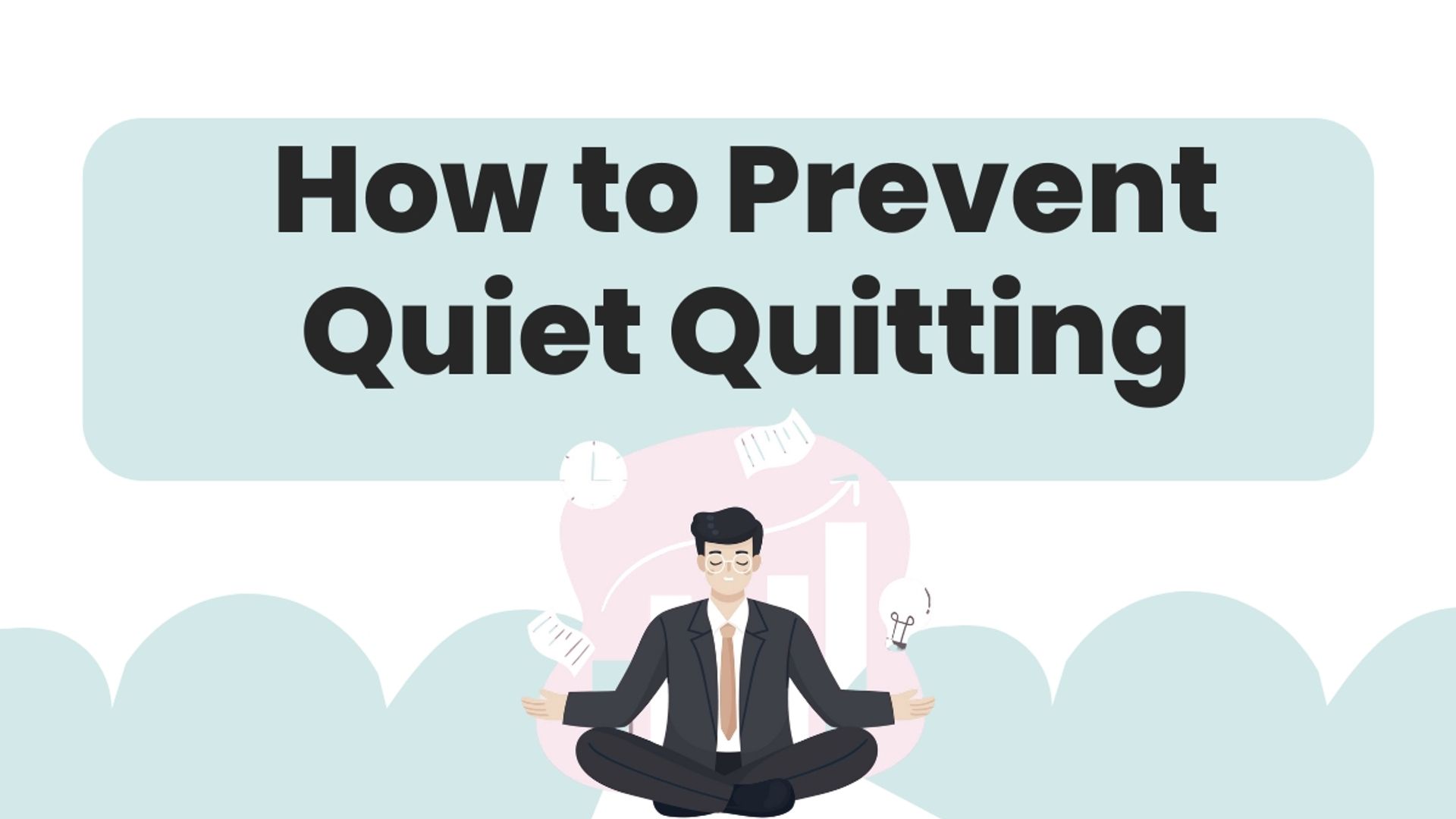The term "quiet quitting" has become a topic of concern in today’s workplaces. It describes employees who perform only the necessary tasks, lacking enthusiasm and commitment. Unlike formal resignations, quiet quitting can be subtle, often going unnoticed until it impacts overall morale and productivity. This behavior can indicate larger issues within the organization, such as ineffective management, lack of career advancement, or poor work-life balance. Addressing these underlying challenges is essential to reducing quiet quitting and creating a more engaged workforce. In this guide, we outline strategies for organizations to prevent quiet quitting, including fostering open communication, offering growth opportunities, recognizing employee contributions, promoting work-life balance, building a positive workplace culture, setting clear expectations, providing necessary resources, improving leadership, managing workloads effectively, and acting on feedback. Boost your team's performance by creating a supportive environment where employees feel comfortable and are encouraged to excel at their work.
Encourage Open Communication
- Safe Spaces: Foster an environment where employees can freely share their thoughts, concerns, and suggestions without fear. Achieve this with tools like anonymous feedback systems, regular surveys, and open forums. Create a workplace culture that values open communication and empowers employees to contribute to continuous improvement.
- Respond to Feedback: Show employees that their input is meaningful by acting on their suggestions and demonstrating that their opinions contribute to ongoing improvements.
- One-on-One Meetings: Regularly schedule individual check-ins between managers and employees to discuss workloads, career goals, and any challenges they may face. These conversations should focus on both personal well-being and professional development.
- Team Discussions: Boost team productivity and cohesion by holding meetings to review project updates, address concerns, and celebrate successes. These sessions foster collaboration and unity, essential for a thriving team.
- Open-Door Policy: Promote an open-door approach where employees feel comfortable raising issues or proposing ideas directly to managers or leaders.
- Clear Communication: Ensure that key messages are communicated clearly across all levels of the organization using various channels like email, newsletters, or internal platforms.
- Manager Training: Equip managers with strong communication and active listening skills to ensure they engage effectively with their teams.
- Curiosity: Create an environment that encourages employees to ask questions and seek clarification, minimizing misunderstandings and promoting a culture of learning.
Provide Growth Opportunities
Drive employee engagement and motivation by providing clear career growth pathways. When advancement prospects are transparent, commitment levels rise. Consider the following strategies:
- Training and Workshops: Regularly offer professional development through workshops that enhance technical skills, soft skills, and leadership capabilities.
- Tuition Assistance: Support employees pursuing additional education or certifications by providing financial assistance, which enhances loyalty and performance.
- Mentorship Programs: Create mentorship opportunities where seasoned employees can guide their peers, nurturing both personal and professional development.
- Reverse Mentoring: Promote knowledge-sharing by having junior employees mentor senior staff, particularly in technology and innovation.
- Clear Career Paths: Provide clear information on career progression within the company, including the skills and experience required for promotion.
- Individual Development Plans: Create personalized development plans with employees that align with their career ambitions. Regularly review and update these plans to ensure continued progress and success.
- Job Rotation: Boost your team's capabilities by implementing rotation programs. Enable employees to move across departments, expanding their skills and enhancing their understanding of your organization.
- Internal Mobility: Encourage internal transfers to fill open roles, allowing employees to explore new career paths without leaving the company.
- Leadership Development: Offer leadership training for employees showing management potential, covering topics such as team management and decision-making.
- Challenging Assignments: Give employees stretch assignments to push their development while aligning tasks with their long-term career goals.
Recognize and Reward Efforts
Boost motivation and engagement by recognizing the hard work your employees put in. Valued efforts lead to commitment. Prioritize appreciation to maintaining inspired workforce. Here are some effective ways to acknowledge their contributions:
- Public Acknowledgment: Celebrate individual and team accomplishments in meetings, newsletters, or internal platforms, showing how their efforts benefit the company.
- Personalized Notes: Handwritten notes of appreciation can have a powerful impact on employees, showing genuine recognition for their contributions.
- Private Recognition: A personal "thank you" during one-on-one conversations can deeply resonate and strengthen the employee-manager relationship.
- Employee Recognition Programs: Establish programs like "Employee of the Month" to publicly honor exceptional performance with tangible rewards.
- Bonuses and Incentives: Offer performance-based bonuses or salary increases to show that hard work leads to meaningful rewards.
- Conference Opportunities: Reward top performers by sending them to industry conferences, which also supports their continued professional development.
- Advanced Training: Provide specialized training opportunities that align with employees' career goals as both a reward and development opportunity.
- Extra Time Off: Grant additional paid time off as a reward for outstanding achievements, helping employees recharge and feel appreciated.
- Flexible Work Options: Offer flexibility, such as remote work or adjustable hours, to acknowledge high performers and support work-life balance.
Promote Work-Life Balance
Achieving a healthy balance between work and personal life is essential for enhancing both employee well-being and productivity. Here are some ways to support this equilibrium:
- Remote Work: Allow employees the option to work remotely, giving them more control over their schedules.
- Flexible Hours: Provide options such as flexible hours, compressed workweeks, or part-time schedules to cater to individual needs.
- Encourage Breaks: Encourage employees to take regular breaks during the day to recharge and maintain their energy.
- Vacation Time: Encourage employees to fully use their vacation days and disconnect from work during time off to prevent burnout.
- Set Boundaries: Implement policies that limit work communication after business hours to maintain clear boundaries between work and personal time.
- Lead by Example: Managers should model a healthy work-life balance by not sending after-hours emails or expecting responses outside working hours.
- Manage Workloads: Ensure that workloads are fair and manageable, preventing stress and burnout.
- Support Systems: Provide access to employee assistance programs and mental health resources to support well-being.
- Wellness Programs: Introduce wellness initiatives such as fitness classes or meditation sessions to enhance overall health.
Build a Positive Work Environment
Enhance employee satisfaction and retention with a supportive, positive work environment. Prioritizing this critical factor is necessary to ensure long-term success. Consider these strategies to create an engaging workplace:
- Inclusive Culture: Foster a culture where everyone feels respected, regardless of background or identity.
- Diversity Training: Promote understanding and eliminate unconscious biases with diversity and inclusion training.
- Team Building: Strengthen team relationships and enhance collaboration with regular team-building activities. Prioritize these events to foster a cohesive and productive work environment.
- Ergonomic Workspaces: Ensure workstations are comfortable and reduce physical strain to boost productivity.
- Transparent Policies: Implement clear and transparent workplace policies to guide decision-making and set expectations.
- Accessible Leadership: Promote leaders to be approachable and open to feedback, dismantling hierarchical barriers. Embrace a culture of openness, where feedback flows freely, enhancing collaboration and innovation.
- Incentive Programs: Reward excellent performance with bonuses, time off, or other meaningful incentives.
Conclusion
Preventing quiet quitting is essential for maintaining a motivated and engaged workforce. By fostering open communication, creating opportunities for advancement, recognizing contributions, ensuring work-life balance, and building a positive work environment, companies can reduce disengagement and promote long-term success. Boost productivity and loyalty by fostering a workplace where employees feel valued, respected, and motivated. Enhance your team's performance with actions that create a thriving environment.


